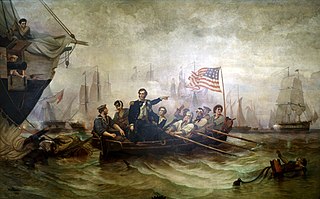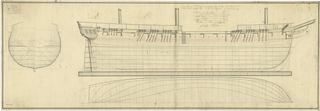
The Battle of Plattsburgh, also known as the Battle of Lake Champlain, ended the final British invasion of the northern states of the United States during the War of 1812. Two British forces, an army under Lieutenant General Sir George Prévost and a naval squadron under Captain George Downie converged on the lakeside town of Plattsburgh, New York. Plattsburgh was defended by New York and Vermont militia and detachments of regular troops of the United States Army, all under the command of Brigadier General Alexander Macomb, and ships commanded by Master Commandant Thomas Macdonough.

The Battle of Lake Erie, also known as the Battle of Put-in-Bay, was fought on 10 September 1813, on Lake Erie off the shore of Ohio during the War of 1812. Nine vessels of the United States Navy defeated and captured six vessels of the British Royal Navy. This ensured American control of the lake for the rest of the war, which in turn allowed the Americans to recover Detroit and win the Battle of the Thames to break the Indian confederation of Tecumseh. It was one of the largest naval battles of the War of 1812.

Admiral of the Blue Sir Alexander Inglis Cochrane was a senior Royal Navy commander during the Napoleonic Wars and achieved the rank of admiral.

The Battle of Baltimore was a battle fought between British and American forces in the War of 1812. American forces repulsed sea and land invasions off the busy port city of Baltimore, Maryland, and killed the commander of the invading British forces.

The Battle of Bladensburg, also known as the Bladensburg Races, was a battle of the Chesapeake Campaign during the War of 1812, fought on 24 August 1814, at Bladensburg, Maryland, 8.6 miles (13.8 km) northeast of Washington, D.C.

The Battle of North Point was fought on September 12, 1814, between General John Stricker's Maryland Militia and a British force led by Major General Robert Ross. Although the Americans retreated, they were able to do so in good order having inflicted significant casualties on the British, killing one of the commanders of the invading force, significantly demoralizing the troops under his command and leaving some of his units lost among woods and swampy creeks, with others in confusion.

HMS Euryalus was a Royal Navy 36-gun Apollo-class frigate that saw service in the Battle of Trafalgar and the War of 1812. During her career she was commanded by three prominent naval personalities of the Napoleonic and post-Napoleonic period: Henry Blackwood, George Dundas and Charles Napier. After the end of the Napoleonic Wars she continued on active service for a number of years, before spending more than two decades as a prison hulk. She ended her career in Gibraltar where, in 1860, she was sold for breaking up.

HMS Aetna was the mercantile Success launched in 1803 at Littlehampton. The Admiralty purchased her in 1803 for conversion into a Royal Navy bomb vessel. Aetna participated in the second Battle of Copenhagen in 1807 and the Battle of the Basque Roads in 1809. Later, she participated in the attack on Fort McHenry in the Battle of Baltimore and the bombardment of Fort Washington, Maryland in 1814, during the War of 1812. The Navy sold her in 1816 and she returned to mercantile service under her original name. She sailed to Calcutta, to Rio de Janeiro, and more locally until she was wrecked in 1823.
HMS Devastation was an 8-gun British Royal Navy bomb vessel launched in 1803 at South Shields as the mercantile Intrepid. The Navy purchased her in 1804. She served in the English Channel, the Baltic, off the coast of Spain, and in the United States during the Napoleonic Wars and War of 1812, most notably at the bombardment of Fort McHenry in the Battle of Baltimore in September 1814. The Navy sold her in 1816.

HMS Erebus was originally built as a Royal Navy fireship, but served as a sloop and was re-rated as such in March 1808. She served in the Baltic during the Gunboat and Anglo-Russian Wars, where in 1809 she was briefly converted to a fireship, and then served in the War of 1812. In 1814 she was converted to a rocket vessel to fire Congreve rockets. While serving off America, Erebus participated in the sack of Alexandria, Virginia, and launched the rockets that bombarded Fort McHenry in Baltimore on 13 September 1814. In March 1815, off Georgia, she fired the second-to-the-last-shot of the war. She was laid up in 1816 and sold for breaking up in 1819.

Admiral of the Fleet Sir James Alexander Gordon, GCB was a Royal Navy officer. As a volunteer, he fought at the Battle of Groix, at the Battle of the Glorious First of June and at the Battle of Cape St Vincent during the French Revolutionary Wars and then, as a midshipman, served under Admiral Sir Horatio Nelson at the Battle of the Nile.

HMS Starr was a 16-gun Merlin-class ship sloop of the Royal Navy. She was built by Tanner, of Dartmouth, to plans by Sir William Rule, and launched in July 1805. As a sloop she served on convoy duty, though she also participated in the invasion of Martinique in early 1809. She was rebuilt as a bomb vessel in May 1812 and renamed Meteor. As Meteor she served in the Baltic and then off the United States, participating in attacks on up the Potomac and on Baltimore and New Orleans. She was sold in October 1816.

The Chesapeake Bay Flotilla was a motley collection of barges and gunboats that the United States assembled under the command of Joshua Barney, an 1812 privateer captain, to stall British attacks in the Chesapeake Bay which came to be known as the "Chesapeake Campaign" during the War of 1812. The Flotilla engaged the Royal Navy in several inconclusive battles before Barney was forced to scuttle the vessels themselves on August 22, 1814. The men of the Flotilla then served onshore in the defense of Washington, DC and Baltimore. It was disbanded on February 15, 1815, after the end of the war.

Fort Washington, located near the community of Fort Washington, Maryland, was for many decades the only defensive fort protecting Washington, D.C. The original fort, overlooking the Potomac River, was completed in 1809, and was begun as Fort Warburton, but renamed in 1808. During the War of 1812, the fort was destroyed by its own garrison during a British advance.

The Engagements on Lake Ontario encompass the prolonged naval contest for control of the lake during the War of 1812. Few actions were fought, none of which had decisive results. The contest essentially became a naval building race, sometimes referred to sarcastically as the "Battle of the Carpenters."

Loire was a 38-gun frigate of the French Navy. She was captured following the Battle of Tory Island by a Royal Navy frigate squadron and subsequently taken into British service as HMS Loire.
HMS Fairy (1812) was a Cruizer-class brig-sloop, built by William Taylor at Bideford and launched in 1812. She escorted convoys during the War of 1812 and participated in the Raid on Alexandria, the Royal Navy’s incursion up the Potomac in 1814. She was broken up in 1821.

HMS Severn was an Endymion-class frigate of the British Royal Navy, launched in 1813 as one of five heavy frigates built to match the powerful American frigates. The shortage of oak meant that she was built of "fir", which meant a considerably shortened lifespan. Nonetheless, the ship saw useful service, especially at the bombardment of Algiers in 1816, before being broken up in 1825.

HMS Hebrus was a 36-gun Scamander-class frigate of the Royal Navy. Constructed in response to the start of the War of 1812, Hebrus was commissioned in October 1813 under Captain Edmund Palmer. Serving initially in the English Channel, on 27 March 1814 the frigate fought at the Battle of Jobourg during which she captured the French 40-gun frigate Étoile in a single-ship action. Hebrus was subsequently transferred to serve in North America. She participated in the expedition up the Patuxent River in August which resulted in the destruction of the Chesapeake Bay Flotilla, and Palmer was also present at the Battle of Bladensburg.

















